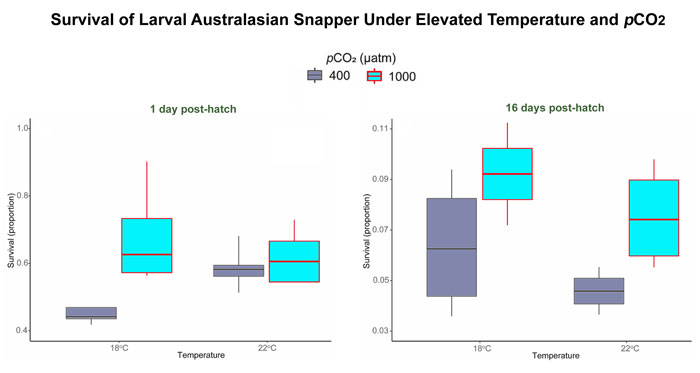| Tweet | Follow @co2science |
Paper Reviewed
McMahon, S.J., Parsons, D.M., Donelson, J.M., Pether, S.M.J. and Munday, P.L. 2020. Elevated temperature and CO2 have positive effects on the growth and survival of larval Australasian snapper. Marine Environmental Research 161: 105054, doi.org/10.1016/j.marenvres.2020.105054.
In a recent study conducted at the National Institute of Water and Atmospheric Research Northland Marine Research Center in Ruakaka, New Zealand, McMahon et al. (2020) investigated the combined effects of ocean acidification and warming on eggs and larvae of the Australasian snapper (Chrysophorys auratus). Adults were captured in the wild from adjacent Bream Bay and kept in a laboratory setting. Following acclimation, spawning was initiated and eggs were cleaned and divided into a full-factorial treatment of two temperatures (18 or 22 °C) and two pCO2 (approximately 400 or 1000 µatm) conditions up to 16 days post-hatching (dph). At 1 dph and 16 dph, the scientists conducted a series of measurements in order to evaluate the single and combined impacts of the two parameters (temperature and pCO2) on C. auratus growth and survival.
And what did their measurements reveal?
In the words of the authors, "both drivers produced positive effects, but on different traits." With respect to growth, at 1 dph fish reared at 22 °C had greater total length, standard length, head length, muscle depth at vent and fin depth at vent than fish reared at 18 °C. By16 dph, such enhanced growth was even more noticeable; standard length and total length were 12% longer, muscle depth at vent was a whopping 63% greater and head depth was 35% bigger. What is more, compared to larvae reared in ambient water (18 °C), elevated temperature stimulated other morphological traits by 21-24%, including eye diameter, mandible length, fin depth at vent, body length and head length. Elevated CO2, on the other hand, had "no significant effects on morphological traits and there were no significant interactions between CO2 and temperature."
With respect to larval survival, elevated CO2 increased survivorship by 27% and 56% at 1 dph and 16 dph, respectively (see Figure 1). Elevated temperature, in contrast, had no impact on this parameter, nor was there any significant interactions between temperature and CO2 on larval survival.
Commenting on their work, McMahon et al. write their results "highlight how these two environmental drivers can affect different fitness-associated traits during early life, and that the effects of higher temperature and elevated CO2 need not be detrimental," adding "for this population of C. auratus, it seems that exposure to predicted future temperatures and CO2 levels could have positive effects on individual fitness." Consequently, the team of researchers conclude (1) the increased growth associated with elevated temperatures "would likely translate to increased survival in the wild as [larvae] would pass through the most vulnerable life stages faster and (2) the enhanced survival associated with elevated pCO2 "would have a positive effect on recruitment to the adult population." Both prospective outcomes should therefore be celebrated for the benefits they will provide to this important commercial and recreational fish species.

Figure 1. Survival of a New Zealand population of the Australasian snapper (Chrysophyrs auratus) under two temperature and two pCO2 conditions at 1 day post-hatch (left panel) and 16 days post-hatch (right panel). Adapted from McMahon et al. (2020).




